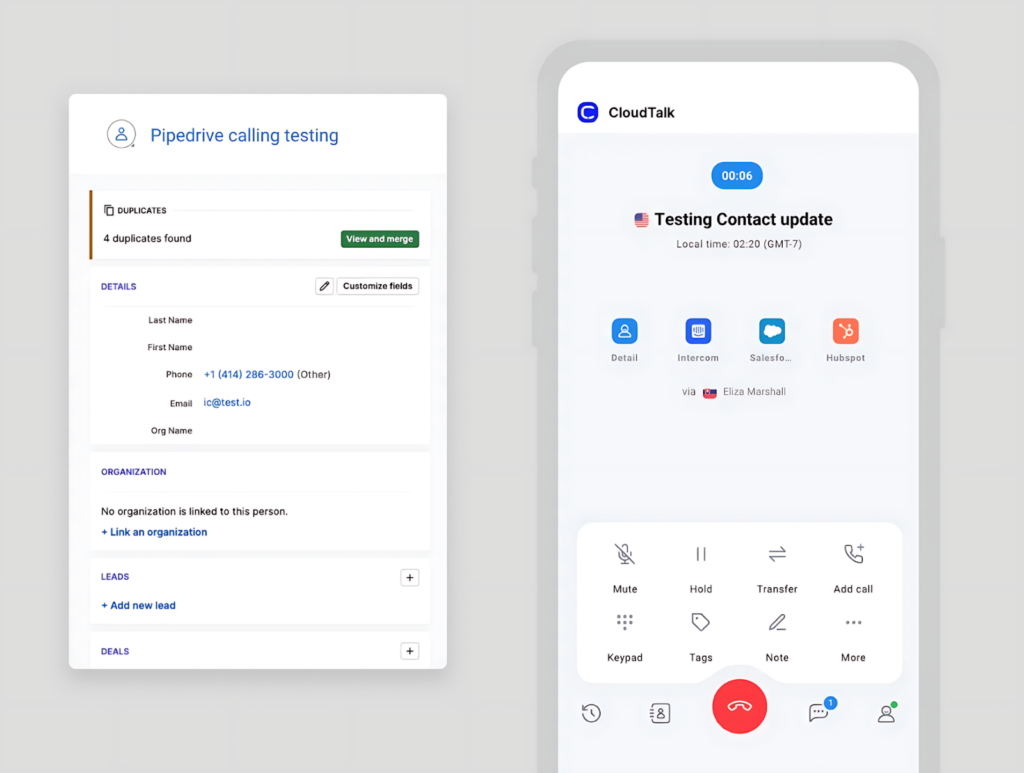8 Sales Prospecting Methods That Actually Work

More than 40%* of salespeople say prospecting is the most challenging part of their job. Closing deals comes second. This tells us a lot about the true challenges salespeople face within the sales process.
You see, researching and qualifying leads can be time-consuming, and it’s hard to win the attention of prospects. Combined with the pressure of hitting quota, it’s no wonder sales professionals are actively seeking advice that helps them cut through the noise and sell better.
In this article, you’ll discover actionable sales prospecting tips and proven ways to keep your pipeline healthy.
Key takeaways:
- Creating a detailed ICP profile is an important, strategic decision. It’s a prerequisite for any sales prospecting process.
- B2B sales is fundamentally different from B2C sales, and requires an entirely different prospecting approach.
- To increase your lead-to-customer ratio, you need the right tools to automate parts of your sales prospecting process
Track performance, analyze calls, and improve your bottom line with CloudTalk
What is Sales Prospecting?
Sales prospecting is the process of identifying and reaching out to potential customers. The goal is to build a pipeline of qualified buyers who are interested in what your company has to offer. This means you need to be strategic about your prospecting efforts.
The first step is to research prospects and gather information about their needs, challenges, and buying behavior. To do so, you might rely on outreach, cold calling, social media, or networking to keep your sales pipeline healthy.
The second step is about qualifying prospects. Here are some useful questions you can ask:
- Are they problem-aware?
- Do they have the budget for your solution? If yes, are they willing to pay for it?
- Do they match the ideal customer profiles (ICPs) your company defined?
- Do they perceive your solution as a must-have or a nice-to-have? If the latter, how big is the gap you need to bridge to convince them otherwise?
- What are their unique pain points and how can your solution effectively solve them?
- Who’s the decision-maker within their company?
Important note
What you consider a qualified prospect is highly specific to your company, revenue targets, and the internal definition of best-fit customers. Keep in mind, this definition will change as your company grows or pivots. It’s important to make sure that your sales team (and all the GTM teams) have a crystal clear picture of the ICP they’re trying to engage.
Finally, when you successfully tackle research and qualification, it’s time to connect with your potential customers. Make sure to record all key information and interactions in your CRM to stay organized and send follow-up emails.
The more you know about your potential buyers, the better you can personalize your outreach. We’ll explore this in greater detail later.
B2B vs B2C Sales Prospecting
B2B is very different from B2C sales. Below, we look at the differences in sales cycle, decision-making process, and buying power.
In B2B, you’re targeting businesses, organizations, or institutions. This means you’re trying to engage an entire buying committee within the company. The financial commitment is significantly bigger compared to B2C sales. As such, there has to be valid justification of the return on investment. This means the sales cycle is often longer and more complex, including negotiations and tailored proposals.
In B2C, you’re targeting individuals. The sales cycle here is much shorter compared to B2B because there’s a single person with buying power. Additionally, the pricing is typically fixed or might include some promotions and special discount offers. In any case, it takes less persuading for potential buyers to make a purchase decision.
Sales Prospecting vs Lead Generation
Sales prospecting and lead generation are two different methods to expand your pool of potential customers.
Sales prospecting is about actively searching for potential buyers. Like we explained above, you’re rolling up your sleeves to do research, qualify leads, and then outreach new prospects, continuously.
On the other hand, lead generation is about attracting potential prospects to your company by creating interest in your product or service. For example, you might create a gated piece of content or build an email list. Then you’d use their contact information to send them marketing communications (they need to opt in, of course).
Summary
Sales prospecting = Actively searching for customers, outbound, and direct. Lead generation = Empowering customers to find your offer, inbound, and attraction-based
Naturally, both sales prospecting and lead generation are broad terms that include dozens of marketing tactics. Sales prospecting covers everything from referrals to personalized emails (more on these below). At the same time, lead generation involves different strategies for website conversions, from PPC to SEO lead generation.
Outbound vs Inbound Sales Prospecting
Now that we covered sales prospecting and lead generation, let’s take a look at the difference between outbound and inbound sales prospecting.
An AI Sales Agent can automate outreach tasks, helping your team connect with more prospects faster and with personalized messages.
Outbound prospecting is all about actively reaching out to potential customers who may not yet be aware of your product or service. This can include cold calling, verifying email addresses for cold emailing, and engaging social selling.
Inbound prospecting is about engaging leads who have already shown interest in your offer. Maybe they downloaded a resource, joined your email list, or attended your webinar. Either way, they already interacted with your brand. Now you need to engage them and guide them through the sales funnel.
Benefits of a Strong Sales Prospecting Process
Having a strong sales prospecting process has a positive impact on revenue and company growth, as well as employee and customer engagement.
We explore the benefits of a strong sales prospecting process in the table below:
Benefit
Description
Compound effect
Better qualified leads
Strong research and prioritizing iterations brings you more relevant potential customers.
Consistently targeting good-fit customers boosts conversion rates and provides valuable insights on ICPs, driving business growth.
Better lead-to-customer ratio
A strong prospecting process improves lead scoring, helping sales professionals close more deals.
As more leads convert, CAC decreases, improving customer acquisition and profitability through retention and upselling.
Shorter sales cycles
Engaging qualified prospects early reduces time on poor leads, increasing efficiency, speeding up need recognition, and shortening the sales cycle
Faster deal closures let your team handle more sales, leading to exponential growth in sales volume and revenue
More precise forecasting
A measurable prospecting process yields predictable results, improving forecasting and giving better control over revenue growth
Fine-tuning forecasting fosters a culture of ownership, empowering departments to make better decisions, measure impact, and seize opportunities
Stronger customer relationships
When you build trust with prospects, you set foundational blocks for long-term customer relationships.
Loyal customers generate new business, stay longer, and enhance your brand’s image.
A measurable prospecting process yields predictable results, improving forecasting and giving better control over revenue growth
The Best Sales Prospecting Techniques
Now let’s take a look at the most effective sales prospecting techniques. We’ll cover everything from sales prospecting tools and best practices to unexpected low-lifts that can make a huge impact on your sales revenue growth.
#1 Create Ideal Customer Profiles (ICPs)
First thing’s first: you need to know who you’re targeting. This means that you have to create ideal customer profiles (ICPs) that are actionable enough for the sales team.
It’s important to emphasize that your ICP is not the same as your target audience.
- Your target audience is the total addressable market that your company can serve.
- Your ICP is the market segment that matches your best-fit customers. In other words, potential buyers that you want to serve.
Defining an ICP is a strategic, company-wide decision. It can change depending on the company’s current focus, in case of pivoting, or in alignment with the new product roadmap. To define an ICP, analyze your most successful customers by examining factors like industry, company size, revenue, location, pain points, and purchasing behaviors.
Here are some things you can look for when deciding your best customer:
- Short sales cycle
- Higher account value
- Companies who don’t take a ton of your experts’ time
- Long retention
- Cultural fit and great customer relationship that leads to recommendations
Your sales reps and GTM teams should always listen to what existing and potential customers are saying and include this intel within your buyer persona documentation.
#2 Leverage Sales Triggers
Sales triggers are events that create an opening for contact with prospects. You’re essentially looking for clues that indicate your prospect might be ready to buy, or that they are now potentially more receptive to your offer.
Here are some signs they may be transitioning to another phase of the sales funnel:
- They received new funding
- Their company went through a significant organizational change (e.g. acquisition or merger), which led to a change in the leadership team
- They are launching a new product offering
- They are expanding to new markets
Keeping a pulse on these changes is important. It creates room for personalized, well-timed outreach that’s likely going to lead to a discovery call.
Pro tip
There are different sales intelligence tools, social media monitoring systems, and alert tools that can help you stay on top of changes happening on the prospects’ side. For example, Google Alerts is a free tool you can set up to track brand mentions, keywords, and phrases. Especially in B2B sales, a “no” can often mean “not now”. Timing plays an important role.
#3 Focus On Warm Calls
Even though cold calling works when what you’re offering is highly relevant to the prospect, warm calls are even better. You have a 4.2 times better chance to schedule a meeting if a person knows you.
It’s really a no-brainer. If you already established a rapport with the lead, they will respond better to your sales pitch. There is already a dose of familiarity with who you are, what you do, and what you have to offer.
Additionally, the call isn’t likely to be perceived as an aggressive sales pitch, but a friendly conversation about how they can work better with the help of your solution.
#4 Use Sales Prospecting Tools
There are a lot of sales prospecting tools on the market. They let you automate parts of the sales prospecting through integrations with various data sources such as CRM systems or social media.
For example, Clay lets you scale personalized outreach with data enrichment tools and AI. It helps sales teams manage and prioritize leads. You can start with a list of leads, either prospected through Clay or from your own CRM.
If you’re looking to enrich your database of contacts, then Hunter Enrichment API would be a great choice. You need an email address as input, and Hunter will enrich the rest of the data points available from publicly available data.
Another very popular sales prospecting tool is LinkedIn Sales Navigator. You can enjoy advanced search and filtering options to find the most relevant prospects. The tool provides insights into company updates and individual profiles. This helps you to design a more targeted and informed outreach.
Some other sales prospecting tools you might consider incflude HubSpot, Sendpulse, and more.
Pro tip
Make sure you use complementary tools that contribute to your prospecting efforts. CloudTalk provides robust call management features that helps sales teams manage and optimize outbound calls.
It also integrates with various CRM systems and supports your sales development efforts. Managers can listen to live calls and provide real-time feedback to sales representatives, which can improve the effectiveness of prospecting efforts.
Plus, with access to your CRM, you can see prospect details the moment you receive the call. With this information readily available, you can have a more personalized conversation with the potential customer. You can also make calls directly from your CRM, be it Salesforce, Pipedrive, or HubSpot.

#5 Take Advantage of Automation
From data entry and note-taking to scheduling follow-up calls, automations make a lot of difference in sales team performance. Here are some of the most common ways you can remove manual work from your process:
- Automate many aspects of the calling process, and reach more prospects in less time (when you automate dialing in your campaigns, you can contact more leads, and get more calls connected)
- Automate the process of lead scoring by setting up criteria based on engagement levels (e.g., email opens, clicks, website visits, webinar attendance)
- Set up automated, trigger-based email sequences (e.g., when someone downloads a very specific whitepaper, they get included in a drip marketing campaign)
- Schedule automated follow-up reminders based on certain criteria
- Integrate automation with your CRM and email marketing software to automatically log interactions, update lead statuses, and track progress through the sales funnel
#6 Send Engaging, Personalized Emails
Personalization should be a part of every sales prospecting strategy. You can rest assured your prospects are busy: They don’t want to receive an unsolicited sales pitch, let alone if it’s generic.
When you think about it, it makes little sense to send email blasts that don’t speak to your potential buyer’s unique pain points. But many salespeople still resort to it because they’re under pressure to hit quota. Although it might seem counterintuitive—playing the long game pays off.
For example, if you’re in B2B sales, start by connecting with relevant prospects on LinkedIn. Be genuinely curious about what they’re going through. Paying attention can lead to meaningful openings—and that’s when a truly relevant, well-crafted email makes the difference.
To strike the right tone, many sales professionals now use tools like an AI Humanizer. These tools help rephrase AI-generated content so it feels more natural, thoughtful, and human – ensuring your outreach doesn’t sound robotic or formulaic.
Here are three short tips:
- Capture their attention with a personalized subject line
- Keep the email about them, be specific, and explicitly call out their pain points
- Make it easy for them to respond and take the next step
Prioritize being helpful and resourceful. Make sure it’s clear you care for the person on the other side of the screen, and that you’re trying to make their lives easier.
#7 Ask For Referrals
What’s better than a sales professional with a top-notch sales pitch? A happy customer base that loves your product.
The truth is, your customers are your best salespeople. You just need to activate them. This can be done through a referral or a customer advocacy program, where they get a referral fee each time they point a new sales lead in your direction.
Here’s another idea: If you have a great relationship with a loyal user, why wouldn’t you take a look at your mutual connections on LinkedIn and ask for an introduction? When people we trust say they trust a total stranger, we’re more likely to trust them, too.
#8 Seek Partnerships for Co-Selling
Co-selling is a highly underrated sales development technique, especially in SaaS. It’s one of the lowest lifts and potentially great gains you can imagine. The idea is to find partners in the space that offer complementary products (e.g., software) to yours, and then create bundled offers. It’s a perfect win-win situation for everyone involved.
Partnering with reputable brands can get you new leads, continuously. All you need to do is create a partnership agreement where you’ll state all the terms and conditions (e.g., commission fees, payouts, co-marketing opportunities), and you’re all set.
Find the Sales Prospecting Methods That Work Best
The tricky part about sales prospecting? There’s really no one-size-fits-all. But there are some evergreen methods that aren’t likely to go out of style: From email personalization and social selling to referrals and partnerships, the list goes on.
What’s important for modern sales professionals is to stay lean. Experiment and iterate quickly, because that’s the best way to make progress. Incremental improvements in your approach add up.
Lastly, don’t underestimate just how much tools can help you out. How we work is equally important as the actual work we do. In addition to your CRM, leverage sales prospecting and AI-powered tools like LinkedIn Sales Navigator, CloudTalk, or Kommo. CloudTalk allows you to streamline outreach with AI automation, build stronger pipelines, and improve sales reps’ efficiency.
Save up to 3 minutes per sales call and close deals faster
FAQs About Sales Prospecting Methods
What are the 5 sales prospecting methods?
There are various sales prospecting methods. The top five include warm calls, social selling, personalized email outreach, referrals, and co-selling with partners.
What are some sales prospecting examples?
Here are a few examples of sales prospecting. Warm calling refers to contacting prospects who have already shown some interest in your offer. Email outreach might follow up on this interest by offering additional value, help, or insights. Co-selling with partners might imply creating bundled offers that are tailored to a shared target audience.
























